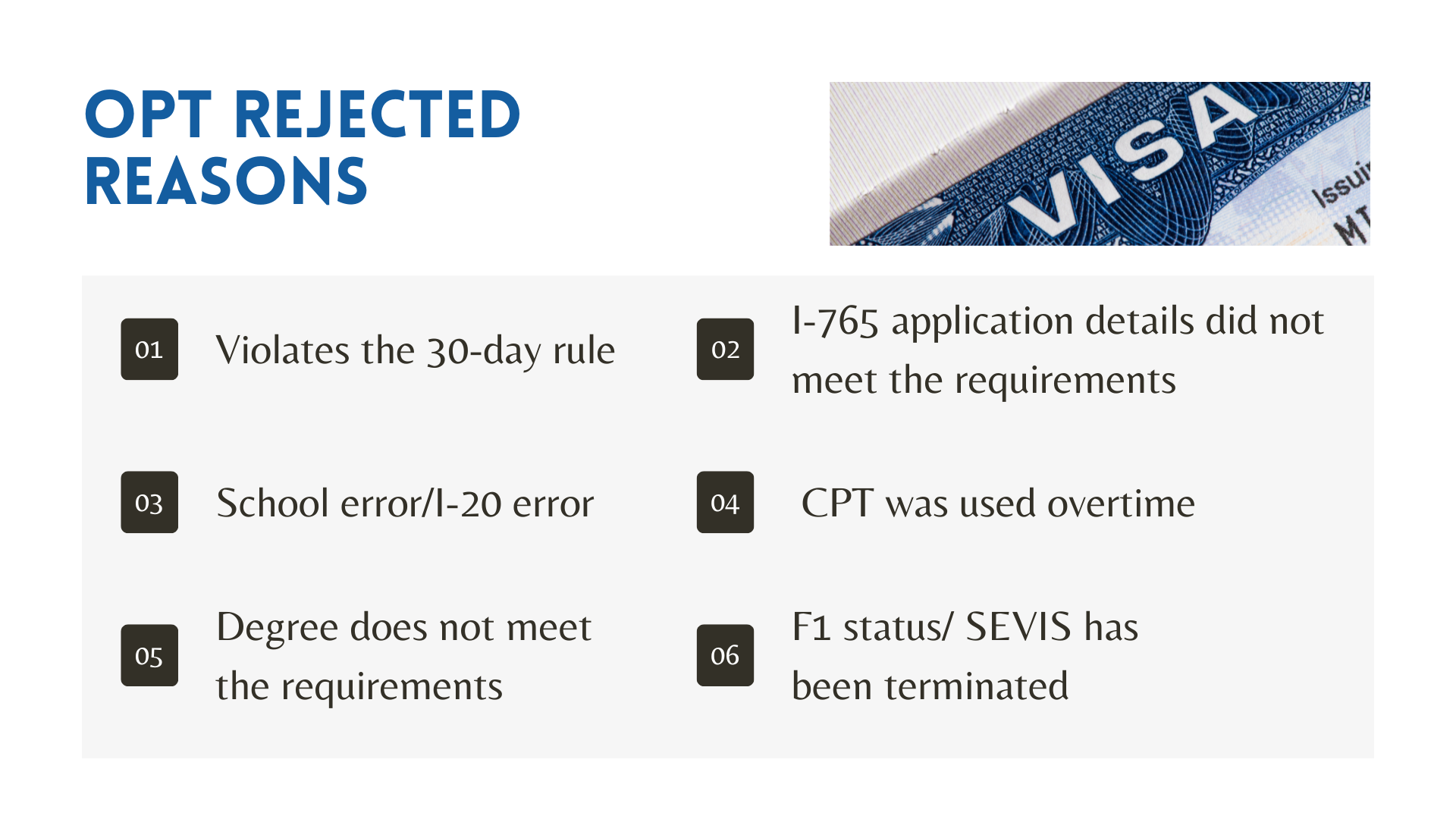
11 Things About OPT and Rejections
OPT
OPT (Optional Practical Training) is employment training directly related to an F-1 student’s major area of study. Eligible students can apply for up to 12 months of employment authorization in below formats:
-
Pre-completion OPT: before completing academic studies
-
Post-completion OPT: after completing academic studies
However, all periods of Pre-completion OPT will be deducted from the available period of Post-completion OPT.
OPT Is a work permit granted by the U.S. government to international students to stay in the United States after graduation. It’s a 1-year work authorization, but STEM majors could get up to 3 years of OPT with STEM OPT extension.
What should I do if my OPT application got rejected?
What does OPT Rejection mean for international students?
It means that the student will lose their legal work status in the United States. If they fail to depart the US within the given time limit, they will become an illegal resident. This would render years of complex study and hard work in vain.
Many recently graduated students have received OPT EAD cards. However, we have also received numerous inquiries from students seeking help after their OPT applications got rejected.
Students who face OPT rejection are understandably concerned and may have questions, for instance:
-
"What should I do if I'm rejected?"
-
"Is there any possibility of appeal?"
-
"What other ways can I stay and work in the United States?”
Hopefully some of your questions can be answered after going through this page.
Typical Cases and Reasons for OPT Rejection

1. Late OPT application submission results in rejection
USCIS enforces the "30-day rule" for OPT applications, requiring applicants to submit their OPT applications within 30 days of the OPT start date recommended by the DSO. Failure to meet this deadline will lead to USCIS rejecting the application. Many students make the mistake of not submitting their application on time and get rejected.
2. Inadequate I-765 materials lead to OPT rejection
Rejected OPT applications often result from incomplete or inaccurate application materials. This frequently occurs because students are unaware of the detailed application requirements. Common mistakes include submitting the incorrect check format, missing information on the I-765 form, forgetting to sign, providing incorrect information, and using the wrong OPT code.
3. School or I-20 errors can cause OPT rejection
When applying for OPT, students must first obtain an OPT recommendation I-20 from the DSO responsible for international student affairs and update their I-20 status in the system. During peak OPT filing periods, it is possible for the DSO to issue the wrong I-20 or forget to update the I-20 status, resulting in submitting the wrong OPT I-20 to USCIS, leading to its rejection. Students must review the documents thoroughly to avoid errors.
4. Full-time CPT for 12 months can lead to OPT rejection
Using full-time CPT for one year cancels out OPT eligibility for this particular degree level. Students must ensure that they use CPT for no more than 11 months or part-time CPT to avoid being rejected for OPT after graduation.
5. Applying with an ineligible degree results in OPT rejection
International students may only apply for OPT once for each degree they obtain. They cannot apply for the same education level multiple times. For instance, if they have already used their master's OPT, then their future degree at the same level will not qualify for OPT application.
6. F1 status or SEVIS termination can cause OPT rejection
For students who change their SEVIS number, the new SEVIS will reset the calculation of their time under F1 student status in the United States. USCIS requires students who have less than one academic year (or two semesters) of student status to be ineligible for OPT. Changing SEVIS numbers or changing their i20 or school within one year of graduation increases the probability of OPT rejection. In such cases, students should defer their graduation or prepare to not have OPT.
*If a student's OPT application is denied, they will receive an OPT Denial Notice from USCIS within 2 weeks, explaining the reason for the denial. OPT denials often lead to I-20 and F1 status lapses, which can affect F1's legal status in the United States. Regardless of the reason for the rejection, students must take immediate action to minimize the impact on their legal status in the US.
Differences between OPT Rejection & Denial
.png)
OPT Rejections
An OPT rejection occurs when the USCIS Lockbox (mailing) Facility sends back your entire OPT application packet without sending it to a Service Center for processing.
Potential reasons why:
-
The payment for your OPT application was unsuccessful, and the transaction could not be completed.
-
Your form I-765 was not signed, rendering the application incomplete.
-
Several required documents are missing from your OPT application packet, which makes it incomplete and thus subject to rejection.
-
You did not provide a reason for applying, which is the very first question on the I-765 form, and as such, the application is incomplete.
-
Your I-765 application used an outdated version of the form, which is not acceptable for submission. We advise you to download the most recent version of the I-765 form directly from the USCIS website each time you apply to avoid such issues.
*Please note that USCIS does not process your payment for a rejection.
OPT Denial
An OPT denial occurs when your OPT application packet is sent to a Service Center for adjudication (processing) and the adjudicator discovers that you are unqualified for OPT.
Potential reasons why:
-
The OPT application packet was submitted to USCIS after the 30-day deadline, which is based on the date ISSS issued your I-20, rendering it invalid and subject to rejection.
-
OPT authorization has already been granted at the same degree level, as the U.S. government permits only one OPT authorization per degree level. As such, the application will not be processed and is subject to rejection.
-
It is apparent that you have not met your eligibility requirements, which include completing one academic year of full-time studies in the United States. The application, therefore, cannot be processed and will be rejected.
-
OPT was applied for after the 60-day grace period had expired, which is not within the allowed period, rendering the application ineligible and subject to rejection.
* If the OPT application is denied, USCIS will still process the payment made, even in the event of a rejection.
What to do if your OPT is rejected
If your OPT application has been rejected, it can be a frustrating experience. You may wonder what options are available to you to stay and legally work in the United States. Here are some solutions that you can consider:
-
Solution 1: Reapply for OPT
If your I-20 has not yet expired and your OPT application was rejected due to errors in the materials submitted, you can reapply for OPT. It is crucial to submit your new application within 30 days of the denial letter, ensuring that the materials are complete and meet the required standards. Contact your International Student Office to obtain a new I-20 immediately after receiving the denial letter.
-
Solution 2: Submit a Motion to USCIS
If you think that the OPT denial decision was incorrect, you can submit a Motion to USCIS. This only applies if USCIS determines that the decision was incorrect. To submit a motion, you need to provide new facts or material evidence to the USCIS. You must submit Form I-290B within 30 days of the denial, along with the required application form, application fee, and supporting documents.
-
Solution 3: Apply to Other Schools to Restore Student Status (🔥Easiest and Safest Option)
Many students choose to apply to other schools to maintain their F1 student status if they cannot meet the requirements for a new OPT application or a motion.
Some universities offer full-time Curricular Practical Training (CPT) opportunities, which allow students to work and maintain their F1 visa status. You can learn more about Day-1 CPT Universities here. Students need to maintain a grade point average of 3.0 or above and follow all the regulations of the school. They also need to ensure that the CPT program and the school are legitimate and comply with immigration laws, schedule a consultation, let us help you find a legit program just for you:
Applying to other schools is a viable solution to restore student status and legal work authorization. However, it is important to act quickly and apply as soon as possible to ensure that there is no gap in your legal status.
-
Solution 4: Convert to Other Status or Visa Type
-
Spouse Visa: Married students can convert to F2 status and legally stay in the United States for a period of time. If the spouse has H1B status and has submitted a green card application, students can switch to H4 status and work legally in the United States.
-
Outstanding Talent Visa: If students meet the criteria for outstanding talents, they can apply for EB1 or O-1 visas. These are programs for outstanding talents, such as Ph.D. holders or individuals who have made significant contributions in the fields of art or sports.
-
Multinational Company Expatriate Visa: If the company that hires students has branches in other countries, they can apply for an expatriate visa and return to the United States to work in L1-B status.
-
Immigration: Students who meet the eligibility criteria can apply for immigration to obtain long-term legal status in the United States.
-
Have a Problem with Your Current OPT/F1 Status?
Think of a legit backup plan, so the most important, your legal status, won’t be jeopardized!
If you want us to help with Day-1 CPT universities based on your locations and needs, Fill out the form and rest assured!

)%20(6).png?width=101&height=101&name=%E8%83%8C%E6%99%AF%20(Canvas%20(Square))%20(6).png)